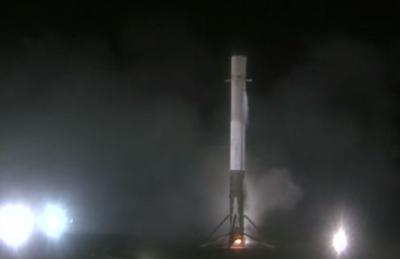Wed, Dec 23, 2015
Shuttle Program Proved That Reusing Spacecraft Is Not As Easy As It Sounds
By Wes Oleszewski, ANN Spaceflight Analyst
On the evening of December 21, 2015 a SpaceX Falcon 9 first stage was successfully landed on Cape Canaveral after boosting its second stage into orbit to deploy satellites. The entire mission was viewed as a huge comeback in the SpaceX effort to return to flight following the loss of a launch vehicle last summer and two previous failures to accomplish the landing of a powered booster on a barge at sea.

This is an amazingly super event... but, it is not over. In order to fully demonstrate the concept that boosters can be returned from a launch and be reused safely and cost effectively the SpaceX folks now have to do the other hard part... they have to do it again.
That is right, they need to safely launch a booster that they have recovered, plus make it cost less than expending the booster. If this booster that was just successfully power-landed on Cape Canaveral should now simply be made into a display at SpaceX headquarters as Elon has reportedly suggested, it would have only served to have demonstrated half of what SpaceX wants to prove.
Just like the first two Space Shuttles STS-1 and STS-2, there would have been no reuse-ability if they had not reused the hardware successfully. In the opening days of the Space Shuttle program, NASA had boasted that the Shuttles would be reusable to the point where they would bring down the cost so far that the missions would actually make money. Additionally their reusability would lend to faster turn-around times for each orbiter due to less maintenance man-hours. Plus the entire fleet could be flown in that mode with each orbiter doing 100 flights in its life-span. Of course none of that turned out to be true and even though the orbiters did demonstrate that they could be reused, the cost of that reuse-ability turned out to be far greater than that of expendable boosters, The question now is, will SpaceX also come up against the myth of spacecraft reuse-ability?
I am not telling you anything that the management and engineers at SpaceX do not already know. While their employees in their California control center celebrate in a grossly unprofessional manner, the fact is that perhaps the bigger challenge for the Falcon 9 still remains to be met by the company’s engineers. Making this historic boost and landing was NOT easy, and making the next one may be just as difficult or perhaps even more difficult.
Also, for the SpaceX hard core critics reading this, keep in mind that once SpaceX starts actually flying pre-flown boosters they will be flight testing in an almost new area of operational flight and failures should be expected. Frankly, pushing into that area is what I will find to be really interesting. I will be glued to the next launch and landing of a once-flown booster. That is the way of spaceflight- once you've done it, it gets harder.
(Image from file)
More News
Aero Linx: Transport Canada We are a federal institution, leading the Transport Canada portfolio and working with our partners. Transport Canada is responsible for transportation p>[...]
Gross Navigation Error (GNE) A lateral deviation from a cleared track, normally in excess of 25 Nautical Miles (NM). More stringent standards (for example, 10NM in some parts of th>[...]
From AirVenture 2017 (YouTube Edition): Flight-Proven Booster On Display At AirVenture… EAA AirVenture Oshkosh is known primarily as a celebration of experimental and amateu>[...]
Aircraft Parachute System (CAPS) Was Deployed About 293 Ft Above Ground Level, Which Was Too Low To Allow For Full Deployment Of The Parachute System Analysis: The day before the a>[...]
Also: 48th Annual Air Race Classic, Hot Air Balloon Fire, FAA v Banning 100LL, Complete Remote Pilot The news Piper PA-18 Super Cub owners have been waiting for has finally arrived>[...]
 ANN's Daily Aero-Linx (06.29.25)
ANN's Daily Aero-Linx (06.29.25) ANN's Daily Aero-Term (06.29.25): Gross Navigation Error (GNE)
ANN's Daily Aero-Term (06.29.25): Gross Navigation Error (GNE) Classic Aero-TV: Anticipating Futurespace - Blue Origin Visits Airventure 2017
Classic Aero-TV: Anticipating Futurespace - Blue Origin Visits Airventure 2017 NTSB Final Report: Cirrus SR22
NTSB Final Report: Cirrus SR22 Airborne Affordable Flyers 06.26.25: PA18 Upgrades, Delta Force, Rhinebeck
Airborne Affordable Flyers 06.26.25: PA18 Upgrades, Delta Force, Rhinebeck



